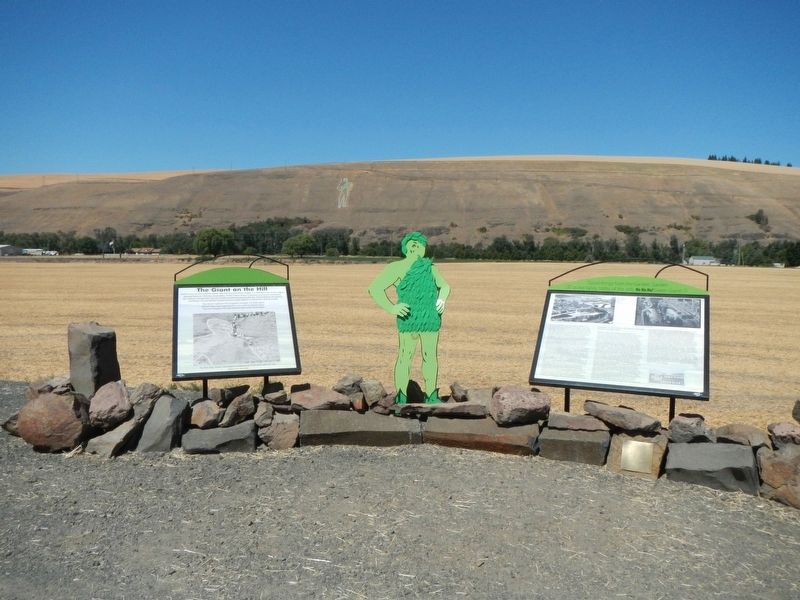Near Dayton in Columbia County, Washington — The American West (Northwest)
"Good things from the Garden,
Garden in the Valley, Valley of the Jolly Ho Ho Ho! Green Giant "
Inscription.
The first vegetable processing plant in Dayton was constructed by Blue Mountain Canneries, Inc. in 1934. The plant was constructed in only 45 days, and on the 46th day, it made its first run with a green pea canning trial. When the plant first opened, the United States was just beginning its recovery from the Great Depression. The first employees were primarily local residents grateful for a steady income, even if it were seasonal. In the following years, pea processing lasted about two months, peas coming from over 23,000 local acres. In 1939, asparagus processing as added, and the plant continued to expand, adding a greenhouse and an agricultural research department to develop more productive pea seeds. In 1942, a labor camp was added to provide housing for workers. In 1947, the cannery merged with Minnesota Valley Canning Co., and in 1950, the Green Giant name was adopted. In the following 50 years, the plant was owned by several larger companies, but the Green Giant label continued to be used. Seneca Foods acquired the plant in 1995, and the plant continued to grow in both production and research. By 2000, the Green Giant Dayton Cannery was the largest asparagus cannery in the world, processing 6,000 acres of asparagus each year and employing 60 full time workers and approximately 2000 seasonal workers. Unfortunately, rising expenses
of labor and housing in addition to the decreased demand for canned asparagus, led to the end of production in 2005. The Seneca Company, however, continued the research and seed production at the plant. There are still approximately 50 employees working to produce 30 million pounds of pea, garbanzo, and wheat seeds.
Dayton's Green Giant plant is a window into U.S. agricultural labor history. Although Dayton's plant first employed all local residents, within five years when asparagus was being grown and produced for Green Giant, seasonal workers from around the United States were recruited to come to Dayton, and in this way, the cannery changed the face of Dayton. The first migrant workers came in 1942 after the labor camp was built. These employees were entirely men who came to work in the fields. In the first three years during World War II, Japanese-American internees and German POWs worked in the fields and in the plant. After the war, an ever-increasing number of men from around the country were recruited. Green Giant used many college students, and the company also recruited employees from Texas, Arkansas, Puerto Rico, the Bahamas, and the Pine Ridge and Rosebud Indian Reservations of South Dakota. Workers were provided a paid trip from their homes and back and travel meal money. Upon their arrival, they were provided housing, health insurance, three meals each day, and wage guarantee for when they were not able to work due to weather or lack of crop maturity. The pay in the processing plant was above minimum wage, and the asparagus cutters would be paid on an incentive basis with a guaranteed minimum wage. If a worker were able to move quickly, the pay was quite good. However, the work was difficult. Although local residents had been working in the plant from the beginning, labor shortages occurred. By the 1960s, Green Giant began recruiting migrant women to work in the processing plant, so the wives of some of the men who had been coming to Dayton for several years began working in Dayton as well. Due to expansion, the company also recruited families to harvest asparagus. Green Giant saw the need to provide family housing and acquired several family units, including mobile homes for family living in the mid-1960s. They would begin arriving in late March to early April, depending on spring weather. School age children would join up with school friends they had met in previous years, and adult acquaintances were renewed. The Green Giant's daycare would be filled with the voices of the very youngest family members. Spanish was heard on the streets, and Dayton's cultural tapestry became richer and more vibrant with the diversity that filled the community each spring.
Erected by Green Giant Company .
Topics. This historical marker is listed in these topic lists: Agriculture • Industry & Commerce.
Location. 46° 18.468′ N, 117° 59.988′ W. Marker is near Dayton, Washington, in Columbia County. Marker is on U.S. 12 near Chandler Road, on the left when traveling east. Touch for map. Marker is at or near this postal address: 36599 US Highway 12, Dayton WA 99328, United States of America. Touch for directions.
Other nearby markers. At least 8 other markers are within 2 miles of this marker, measured as the crow flies. The Giant on the Hill (here, next to this marker); Dodge Quarantine Cabin (approx. 1.1 miles away); Cayuse, Umatilla, and Walla Walla Homeland (approx. 1.1 miles away); "a good road" (approx. 1.1 miles away); Smith Hollow Schoolhouse (approx. 1.1 miles away); The Celilo Falls Trail (approx. 1.3 miles away); Oldest Existing Depot in the State of Washington (approx. 1.3 miles away); Railroad Track Park (approx. 1.3 miles away). Touch for a list and map of all markers in Dayton.
Credits. This page was last revised on October 31, 2020. It was originally submitted on October 31, 2020, by Barry Swackhamer of Brentwood, California. This page has been viewed 350 times since then and 66 times this year. Photos: 1, 2. submitted on October 31, 2020, by Barry Swackhamer of Brentwood, California.

